Did you know that 75% of children and young people benefit from the arts? They grow better in thinking, feeling, and social skills. The language learning through art can make a big difference in their lives.
Adding creative arts to lessons makes students more involved and learn better. It’s a chance for them to try new things without worrying about failing. This helps them grow intellectually.
The Ministry of Education in Cambodia is using a special arts guide to improve teaching. Aide et Action, a global group, has been working in 25 countries since 2003. They focus on quality and inclusive education, especially in Cambodia.
But, only about 2% of schools in Cambodia teach arts. This shows we need to do more to help students grow their talents.
Understanding the Power of Arts in Language Development
The visual arts are key for kids’ growth in many areas. They help with thinking, moving, speaking, and feeling. Art lessons make learning fun and boost language skills. They are especially helpful for kids learning English and those with different learning needs.
Studies show art lessons are great for language skills. A study found that art helped kids with learning disabilities speak better. Kids learning English as a second language also did well in art lessons.
Teachers say art makes learning more fun. It helps kids learn in their own way. The arts help kids connect new ideas to words through pictures and actions.
“The arts are natural for young children, as play is their primary mode of learning and development. Integrating arts into early childhood learning is essential for comprehensive development.”
Many experts agree that art is good for learning languages. Teachers like Mai Chue Xiong and Nicole Potsane lead the way. They show how art can make learning fun and welcoming for all students.
The Evolution of Creative Arts in Education
The role of creative arts in education has changed a lot over time. In Cambodia, arts and culture have played a big part in the country’s recovery after the 1970s genocide. Yet, despite challenges like classroom shortages and teacher training issues, creative arts in schools are still valued.
Cambodia’s arts scene has seen a big comeback, showing how the arts can help rebuild and restore identity after conflict. This growth shows why we should include creative language learning ideas and art games in school curriculums.
“Over 30 years of educational experience, with a focus on integrating art into STEM education, has shown the power of the ‘A’ for art in STEAM education. Art can foster critical observation skills, demand perseverance and resilience, and promote cultural understanding and diversity.”
The way we teach creative arts has also changed, moving towards a more holistic approach. This means using the arts in many subjects to make learning more engaging and effective. It helps prepare students to be both artists and innovators.
Recent studies have found that arts-based education is very effective, especially in the early years. They show that arts like dance, drama, music, and visual art help students learn better and develop skills for future learning.
As education keeps changing, using creative language learning ideas and art games will become even more important. They will help create a diverse and inclusive learning environment that meets the needs of all students.
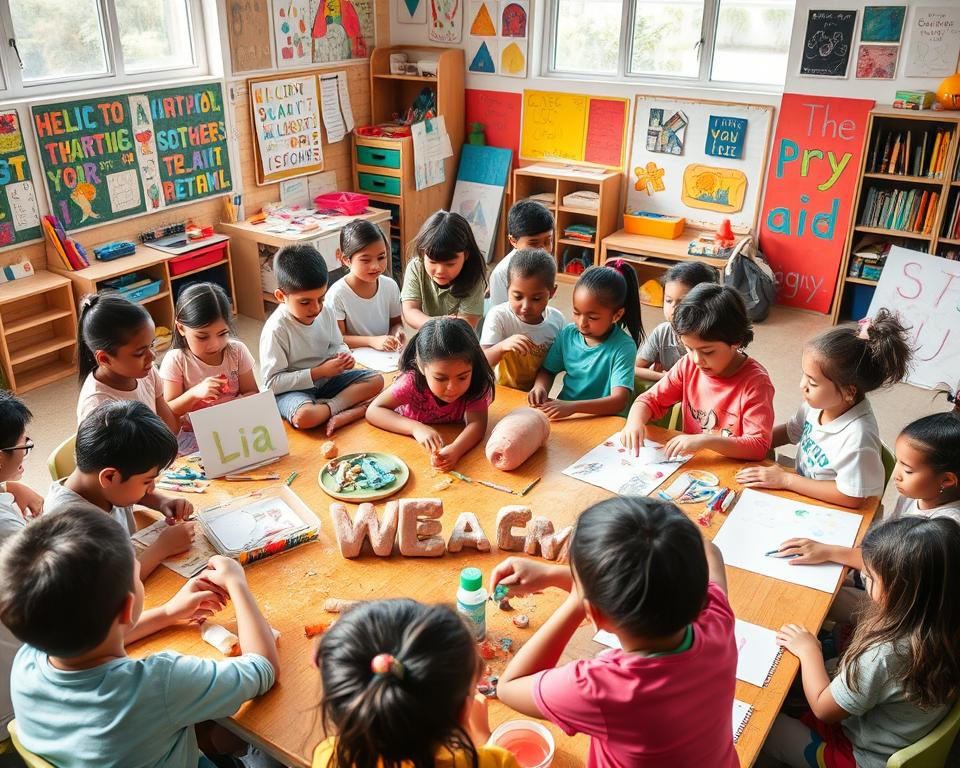
Language Learning Through Art: Core Principles and Methods
The ‘Learning Through Creative Arts’ program uses art to boost language learning. It offers a wide range of artistic mediums. This makes learning fun and engaging for students.
This method believes that learning a language works best when it’s interactive. Art lets students see language in a new way. They get to be creative and learn more about the language and culture.
- Backward design is key for teaching languages. It focuses on planning and using the target language in all lessons.
- Interactive tasks make reading and listening better. They use real cultural texts and follow-up activities to improve skills.
- Students practice speaking and listening by sharing information and opinions. This helps them get better at communication.
- Learning grammar is more fun when it’s part of real conversations. This makes students more confident in their language skills.
Feedback is crucial for language learning. Students get help through different kinds of assessments. This helps them improve their language skills.
“The use of the target language in language learning includes all aspects of language production and reception by learners, educators, and materials.”
The ‘Learning Through Creative Arts’ program makes learning fun through art. It creates a welcoming space for students to grow. They learn languages, cultures, and develop a love for learning.
Learning a language is undoubtedly a challenging yet rewarding endeavor. The process can be made even more enjoyable and effective when combined with the creative power of art. Incorporating art into language learning taps into a different part of the brain, making connections that help reinforce vocabulary and grammar in a unique way. In this blog post, we will explore the core principles and methods of using art as a tool for language learning.
1. Immersion in the Language: One of the key principles of using art for language learning is immersing oneself in the target language. By exposing oneself to various forms of art in the target language – whether it be literature, music, visual art, or film – learners can absorb the language in a more natural and intuitive way. This immersion allows learners to pick up on the nuances of the language, such as tone, rhythm, and cultural references.
2. Visual Learning: Visual aids have long been proven to enhance language learning. When learners engage with visual art in the target language, they are able to associate words and phrases with images, making vocabulary retention easier. This visual stimulation can also help improve reading comprehension and expand one’s cultural understanding.
3. Creative Expression: Art offers a platform for learners to creatively express themselves in the target language. Whether through writing poems, creating visual interpretations, or performing skits, learners can actively engage with the language in a way that is both fun and meaningful. This creative expression not only reinforces language skills but also fosters a sense of ownership and connection to the language.
4. Cultural Context: Art is deeply intertwined with culture, providing a rich backdrop for language learning. By exploring the art forms of a particular culture, learners gain insights into the customs, traditions, and values of the people who speak the language. This cultural context not only enhances language proficiency but also promotes cross-cultural understanding and appreciation.
5. Multi-Sensory Approach: Incorporating art into language learning engages multiple senses, making the learning experience more holistic and engaging. From listening to music and watching films to analyzing paintings and reading literature, learners are able to immerse themselves in the language through a variety of sensory channels. This multi-sensory approach not only reinforces language skills but also makes the learning process more dynamic and enjoyable.
Integrating art into language learning offers a creative and effective approach to mastering a new language. By immersing oneself in the language, engaging with visual art, expressing creativity, exploring cultural context, and embracing a multi-sensory approach, learners can enhance their language skills and deepen their connection to the target language. So whether you’re a beginner or an advanced learner, consider incorporating art into your language learning journey for a truly enriching experience.
Benefits of Art-Based Language Learning for Children
Art-based language learning is great for kids. It helps with thinking, moving, social skills, and feelings. Art education in early childhood learning promotes the development of fine motor skills through activities like tearing paper, using scissors, gluing materials, and painting, which enhance hand-eye coordination and dexterity.
Art-making engages children in multisensory experiences, fostering active learning and hands-on exploration, which triggers the development of neural connections in the brain as children create artworks using different materials. This helps kids see and understand things better. It also makes them better at noticing patterns and understanding space.
Art-based learning makes kids think better, imagine more, and solve problems. Art activities boost self-esteem and confidence by allowing children to master skills and understand that there is no one “right way” to create art, encouraging creativity and autonomy.
Cultural education through art teaches kids about the world. It shows them different views, histories, values, and traditions. This helps them share ideas and feel more about themselves. Art also helps kids deal with their feelings. It’s a way for them to express themselves without words.
“Art-making tools can be inventive and include various objects beyond paintbrushes, such as leaves, whisk, or cotton swab, fostering creativity and exploration.”
Activities like drawing and rubbing textures with crayons on paper help kids see and touch things better. They learn about shapes, textures, and views. Doing art, like making collages or outdoor art, makes kids more creative and emotional.

Creating an Inclusive Creative Learning Environment
Inclusive education is more than just training teachers. It’s about breaking down barriers and making schools welcoming for everyone. The ‘Learning Through Creative Arts’ method helps teachers adapt activities for students with different needs.
This approach helps schools accept and include students with disabilities. By using creative language learning ideas and visual arts for language development, teachers make classrooms welcoming for all. This ensures that every student feels included and engaged, no matter their background or ability.
- Inclusive classrooms focus on building community and accepting differences. They promote a positive attitude.
- Diversity in family, culture, language, and socioeconomic status is crucial in inclusive classrooms.
- Creative art activities help students learn from each other, building community.
- Highlighting students’ strengths in inclusive settings boosts self-esteem and community spirit.
“Inclusion efforts should promote a ‘can-do’ attitude among students, with additional supports provided to aid full participation in learning activities.”
By using creative language learning ideas and visual arts for language development, teachers can make learning fun and inclusive. This approach helps students feel part of a community. It also supports language skills and promotes a sense of belonging.
Creating an inclusive creative learning environment is essential for fostering a supportive and enriching atmosphere for all students to thrive. By incorporating diversity, equity, and inclusion into teaching practices, educators can enhance the learning experience for students of all backgrounds and abilities.
One way to create an inclusive creative learning environment is to provide a variety of materials and resources that reflect the diverse identities and experiences of students. This can include incorporating literature, visual art, and music from different cultures and communities into the curriculum. By exposing students to a wide range of perspectives and voices, educators can help them develop a greater understanding and appreciation for the world around them.
Another important aspect of creating an inclusive creative learning environment is fostering a sense of belonging and community within the classroom. This can be achieved through activities that promote collaboration, communication, and teamwork among students. By encouraging students to work together and support one another, educators can help create a positive and inclusive space where all students feel valued and respected.
In addition, educators can also incorporate strategies for differentiating instruction to meet the needs of students with diverse learning styles and abilities. This can include providing alternative assignments, assessments, and learning opportunities that cater to the individual strengths and challenges of each student. By acknowledging and accommodating the unique needs of all students, educators can help create a more equitable and inclusive learning environment.
Ultimately, creating an inclusive creative learning environment is about recognizing and celebrating the diverse perspectives, talents, and experiences that each student brings to the table. By cultivating a sense of community, promoting collaboration, and embracing diversity, educators can help create a supportive and enriching environment where all students can learn, grow, and succeed.
Implementing Visual Arts in Language Lessons
Adding visual arts to language lessons can really boost learning and grab students’ attention. Activities like drawing, painting, and sculpting make learning fun. They help students remember words, grammar, and stories better.
The guide “Language Learning Through Art” looks at art history from the late 19th century to the 1960s. It covers Impressionism, Cubism, Surrealism, Abstract Art, and Contemporary Art. Yale University Art Gallery offers free tours for school kids, which is great for teachers.
Using paintings to teach shapes, math, colors, and numbers is a smart move. It makes learning less stressful. The guide stresses the value of learning vocabulary through art.
- Over 70 years of art history covered in the guide
- Diverse art movements and artists explored
- Free art gallery tours for public school students
- Using paintings to teach language concepts
- Engaging learners through art-related activities
- Developing vocabulary to support language acquisition
By adding visual arts to language lessons, teachers can make learning more fun and inclusive. This method encourages creativity and deepens language understanding. It’s all about using art to express and learn.
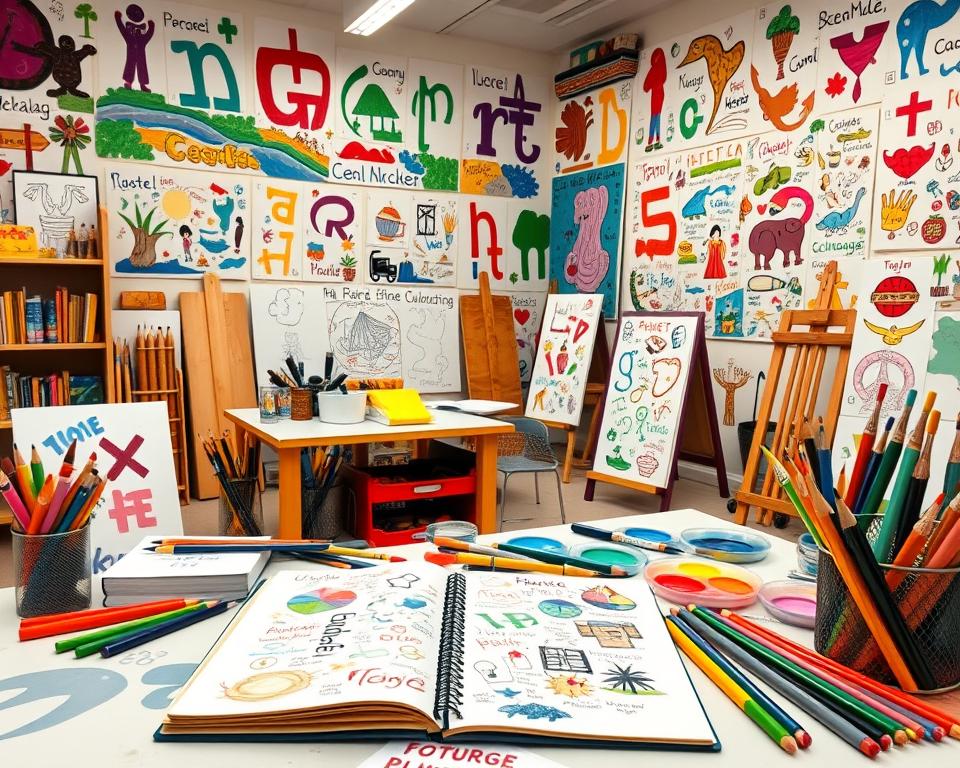
“Using art as a teaching tool can broaden students’ vocabulary in language learning, helping them engage with the material in a more natural and enjoyable way.”
Integrating visual arts into language lessons can be a powerful tool for engaging students and enhancing their understanding of the material. By incorporating visual elements such as paintings, photographs, videos, and other forms of visual media, teachers can create a multi-sensory learning experience that caters to different learning styles and helps students retain information more effectively.
One way to implement visual arts in language lessons is to use images to prompt discussion and spark creativity. For example, teachers can show students a painting or photograph and ask them to describe what they see, identify key elements, and interpret the underlying message or theme. This not only helps students practice their language skills, but also encourages them to think critically and engage with the material on a deeper level.
Another way to incorporate visual arts in language lessons is to use videos or multimedia presentations to introduce new vocabulary and concepts. For instance, teachers can show a video clip that features a dialogue between native speakers or a short film that illustrates a cultural custom or tradition. By exposing students to authentic language use in context, visual media can help reinforce vocabulary and grammar structures in a more meaningful way.
Furthermore, visual arts can be used to inspire creative writing and storytelling activities. Teachers can show students a series of images and ask them to write a narrative that connects the visuals together. This exercise not only encourages students to practice their writing skills, but also fosters creativity, imagination, and critical thinking as they weave together the elements of the visual story.
Thus, integrating visual arts into language lessons can be a valuable teaching strategy that enhances student engagement, comprehension, and retention of information. By incorporating visual elements such as images, videos, and multimedia presentations, teachers can create a dynamic and interactive learning environment that caters to the diverse needs and learning styles of their students.
Music and Movement as Language Learning Tools
Music and movement are now key tools in language learning. Songs and rhymes help learners grasp language patterns and improve speaking skills. They also grow their vocabulary. Movement-based exercises make learning fun and memorable, especially for kids.
A study showed a middle school teacher’s success with a student who excelled in art despite language barriers. This led to better grades and meeting deadlines. Visual arts also help lower grades understand compound words, boosting their language and literacy skills.
“Picto-spelling” is a creative method where students draw words to learn their meanings. It boosts word understanding and makes learning fun and interactive.
Dance and movement are also powerful tools in language learning. A college professor’s dance challenge led to better learning than traditional methods. Movement can also help in math, making it a hands-on experience.
“Dance and movement can be highly effective in language learning. A college professor’s challenge for students to dance DNA led to significant learning outcomes compared to traditional methods.”
At ITALS school, seven teachers work with kids in dance, music, and more. The curriculum covers PK3 to 8th grade, blending arts and language. It meets national standards and offers a well-rounded education.
Using music, movement, and language together makes learning fun and engaging. It helps students learn, be creative, and love learning more.
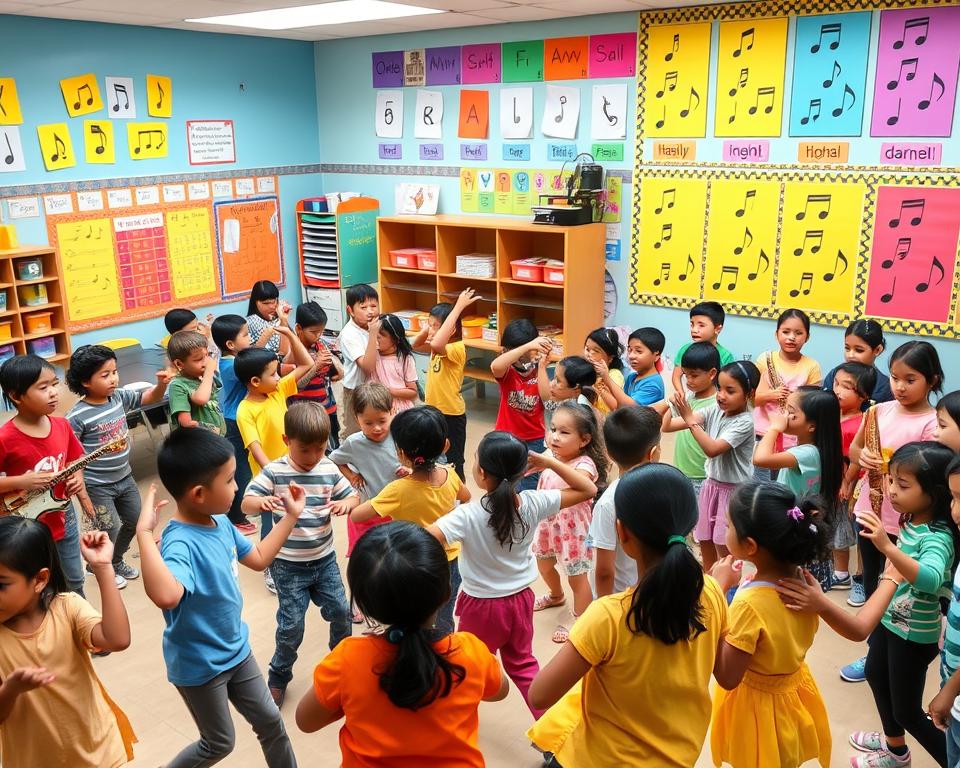
Drama and Role-Play in Language Acquisition
Drama and role-play activities are great for learning languages. They make learning fun and real. Students get to use the language in real-life situations, improving their speaking and listening.
Drama lets students be different characters. They explore social situations and cultural differences. Acting out dialogues helps them understand the language better.
Role-playing is like practicing real-life conversations. Students can order food or ask for directions. This makes them more confident and fluent.
“Engaging in dramatic play scenarios enables children to develop a sense of self-confidence as they embody different roles and experiment with diverse personas.”
Adding Total Physical Response (TPR) and Communicative Language Teaching (CLT) to drama lessons helps too. These methods make learning active and interactive.
These activities also teach important life skills. Students learn to solve problems, think critically, and work together. Drama and role-play build a sense of community and support language learning.
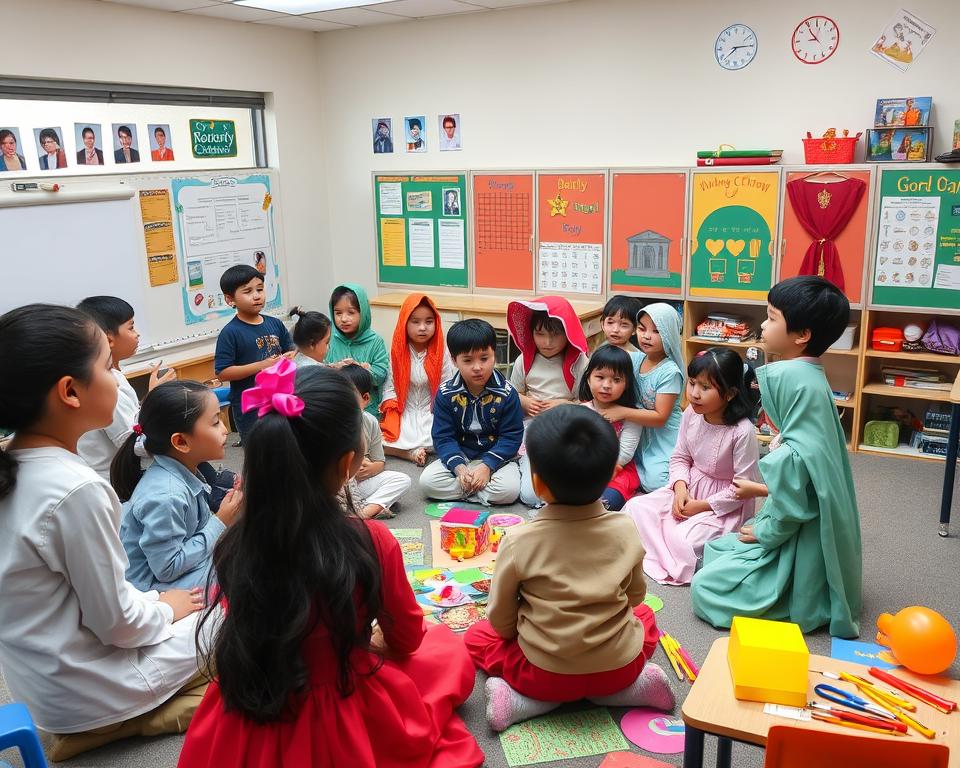
Using drama and role-play in language learning is exciting. It makes learning through art fun and engaging. Educators can help students become confident and skilled in using language in many situations.
Creative Projects for Language Development
Engaging young learners in fun art activities boosts their language skills. They can make comic strips, posters, and short films. These projects improve their language use and artistic skills.
The Caterpillar Craft is a great example. It helps kids recognize colors and improve their language. The Coffee Filter Butterflies craft also enhances their language skills by naming colors.
The Toilet Paper Roll Frog project improves following directions and comprehension. Making a Collage helps with vocabulary and naming items. The Cactus Handprints craft teaches longer phrases and sentences.
The Paper Plate Lion Craft focuses on the /l/ sound. These activities make learning fun and boost imagination.
Using art in language lessons makes learning fun and inclusive. Visual arts open new ways for language learning. It lets students express themselves in unique ways.
“Drawing helped me remember details, gave me ideas, and helped me because I could look and say what I thought.”
Art is for everyone, not just artists. It helps scientists, biologists, mathematicians, and engineers too. It boosts their confidence and academic success.
Discover the fun of fun art activities for language learners and art games for language development. They make learning engaging and rewarding for your students.
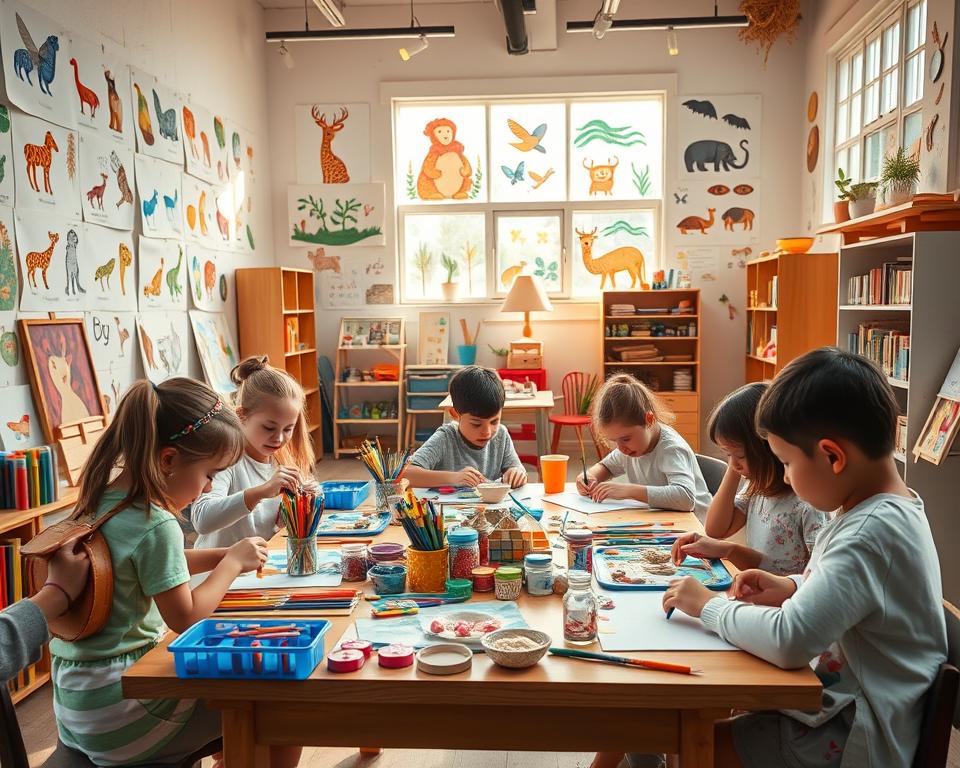
Language development is a crucial aspect of a child’s growth and learning process. It plays a vital role in their ability to communicate, understand, and interact with the world around them. One of the most effective ways to enhance language development in children is through creative projects that engage their imagination and encourage them to express themselves. Here are some creative projects that can help promote language development in children.
Storytelling & Writing
- Create Your Own Storybook: Kids write and illustrate their own short story.
- Daily Journal: Encourage daily entries focusing on feelings, events, or prompts.
- Collaborative Story Chain: Each child contributes a sentence or paragraph to a group story.
- Character Sketches: Draw and describe fictional characters in detail.
- Rewrite a Fairytale: Give a classic story a modern or alternative twist.
Speaking & Listening
- Show and Tell: Present favorite items or experiences, enhancing speaking confidence.
- Role-Playing Scenarios: Simulate real-life situations, such as shopping or doctor visits.
- Podcast for Kids: Record a group podcast about favorite topics or storytelling.
- Interview a Friend or Family Member: Practice question formation and listening.
- Speech Bubble Comics: Create comics with dialogue to practice conversational phrases.
Vocabulary Building
- Scavenger Hunt with Words: Find items based on descriptive clues or vocabulary.
- Word Collage: Cut and paste words from magazines to form sentences or themes.
- Themed Word Lists: Create word posters for specific themes (e.g., animals, emotions).
- Word Jar Challenge: Draw a word from a jar and use it in a sentence or story.
- Vocabulary Bingo: Play Bingo using thematic words to reinforce learning.
Reading Enrichment
- Read & Act It Out: Read a story and act it out with props or gestures.
- Create a Book Trailer: Record a short video “trailer” for a favorite book.
- Shared Reading: Pair children to read aloud to each other.
- Story Mapping: Make visual maps of stories, including characters, setting, and plot.
- Library Scavenger Hunt: Search for books based on specific categories or themes.
Creative Arts Integration
- Language Art Mural: Create a large mural with drawings and descriptive words.
- Songwriting: Write and perform songs focusing on key vocabulary or grammar.
- Puppet Show: Make puppets and put on a show using targeted language skills.
- Cooking Instructions: Follow recipes to practice sequencing and imperative verbs.
- Dramatic Play Scripts: Write and act out mini-dramas or skits with peers.
These projects combine creativity with practical language practice, engaging kids in fun, immersive ways to develop their reading, writing, speaking, and listening skills.
Assessment and Progress Tracking in Art-Based Learning
Assessing progress in art-based language learning needs a full view. Traditional tests might miss the mark. Visual learning and art-based ESL lessons for kids need new ways to measure growth.
Teachers should look at both language and art skills when checking student progress. Using portfolios, project-based tests, and peer feedback can give deep insights into students’ learning paths.
- Portfolios: Collecting students’ work, like sketches and finished art, shows their growth over time.
- Project-based Assessments: Looking at students’ teamwork and creative projects shows their skills in language and art.
- Peer Evaluations: Students giving feedback on each other’s work helps everyone learn and think about their own work.
These new ways to assess help teachers really understand their students’ growth. It shows the value of visual learning and art-based ESL lessons for kids.
“Assessment in the arts is used to guide teaching, track student progress, give feedback, and show what students have learned over time.”
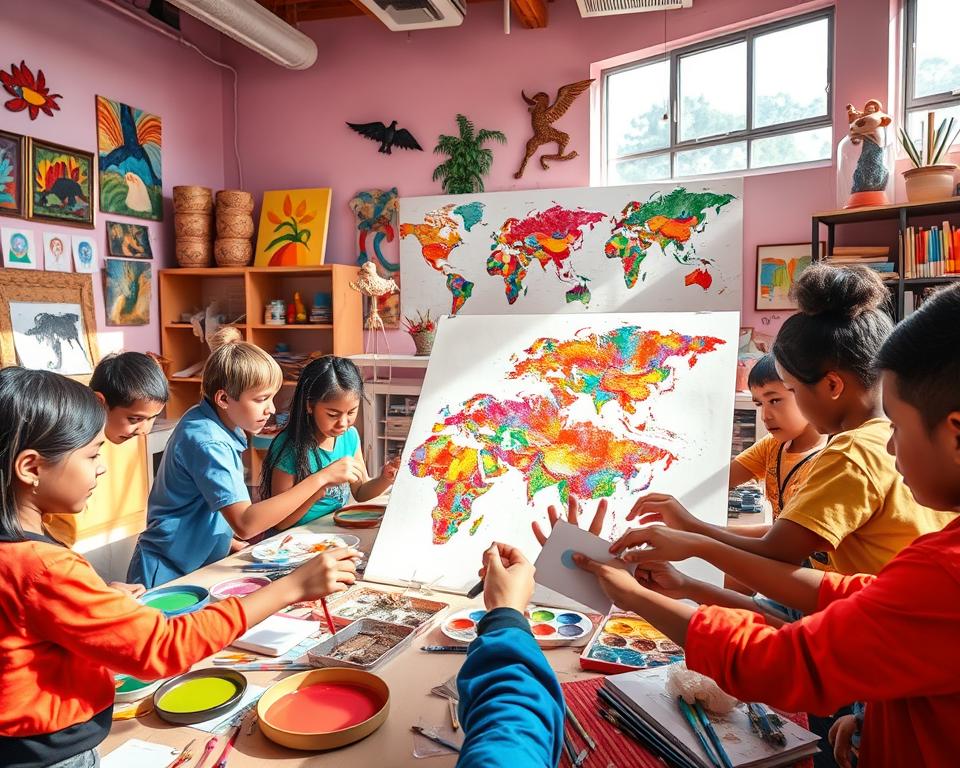
By taking a holistic view of assessment, teachers can create a place where students grow in language and art. It’s a space where creativity and learning thrive together.
Technology Integration in Creative Language Learning
In today’s world, technology is a key tool for making language learning fun. It lets teachers use digital tools to help students learn through art and multimedia. This way, students can explore language in new and exciting ways.
Students can make digital art and multimedia projects that show off their language skills. They can work on projects with others from all over the world. This helps them learn from different cultures and perspectives.
Technology also lets students experience language in a new way. They can use virtual reality to step into different worlds. This makes learning a fun and memorable experience.
Using technology in language learning makes it more engaging. It also gives students access to more resources. Studies show that arts in learning help students with disabilities think and learn better. Teachers can tailor lessons to fit each student’s needs and learning style.
“The arts have been connected to academic achievement, particularly in areas like listening to music and spatial-temporal reasoning, learning to play music and spatial reasoning, and classroom drama and verbal skills.”
There are many ways technology can help with creative language learning. From apps and digital stories to online projects and virtual tours, the options are endless. This approach makes learning fun, engaging, and inclusive.
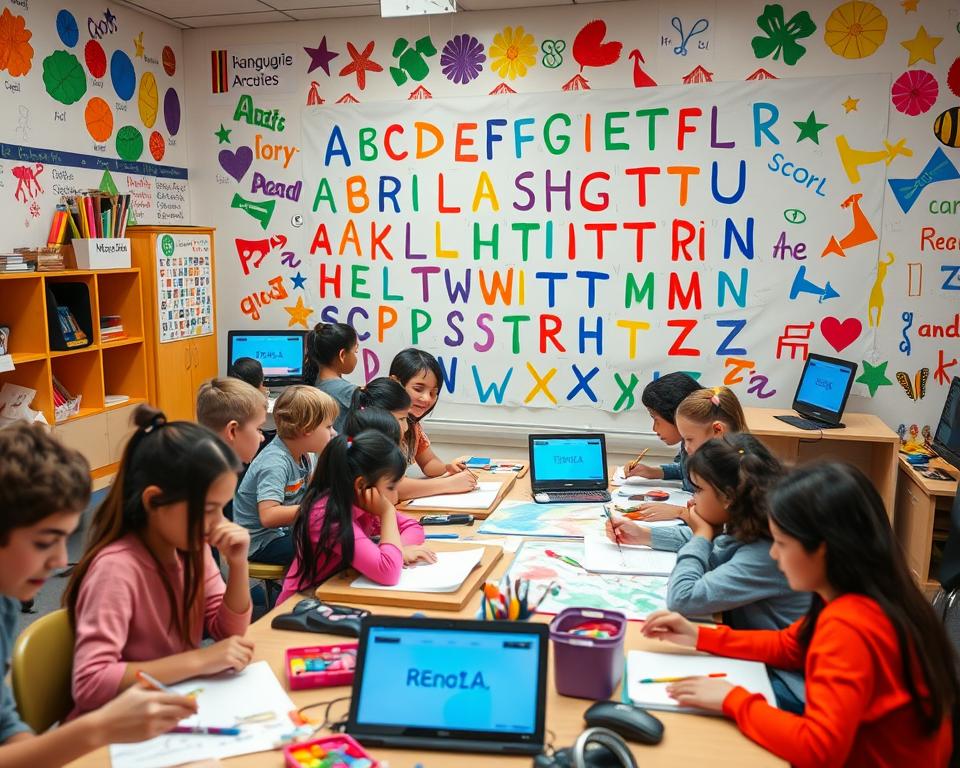
- Computer graphics programs can provide alternative ways for students with disabilities to express themselves, and using technology in creative pursuits can adapt concepts to meet the diverse needs of students.
- Sharing digital arts allows for peer critique, enhancing students’ communication skills in the digital 21st century.
- Technology tools for integrating arts include software like Paint (Windows) for digital art, MovieMaker and iMovie for multimedia projects, GarageBand for music learning, and free programs like JamStudio, ArtRage, and Destination Modern Art to support creative growth.
By using technology in language learning, teachers can make lessons exciting and engaging. This approach helps students become proficient in language, creative, and ready for the 21st century. The possibilities are endless, and the benefits for students are huge.
Learning languages through art is a fun and complete way to learn. It boosts creativity, thinking skills, and understanding of different cultures. It also helps improve language skills.
Teachers can make learning more fun and effective by using art in their lessons. This approach makes learning more inclusive and engaging. It’s important for schools to support this method with the right tools and training.
Combining language learning with art can really help students do better in school. This guide has shown how art and language can work together well. Teachers who use this method will see their students do better and enjoy learning more.
The way we teach is changing, and we need new and better ways to teach. This guide gives teachers the tools to make learning languages more exciting. By using creativity and art, teachers can help students become better language learners for today’s world.
Key Takeaways
- The creative arts have immense potential to enrich the lives of children and young people by promoting cognitive, personal, and social skills development.
- Integrating creative arts into lessons increases student participation, engagement, and learning rates.
- A creative curriculum encourages learners to take chances, fostering the development of critical thinking skills.
- The Ministry of Education in Cambodia has embraced the ‘Learning through Creative Art’ manual to enhance teaching quality.
- There is a need for revised and promoted arts education in Cambodia to develop students’ talents and capacities.
Source Links
- PDF – https://action-education.org/sea/wp-content/uploads/sites/40/2022/12/Learning-through-creative-arts-training-manual-guide-1.pdf
- English Through Art—Incorporating Art in the ESL/EFL Classroom through Peer Collaboration to Encourage Language Production, Acquisition and Learning Outcomes – https://www.scirp.org/journal/paperinformation?paperid=136147
- How and Why the Arts Support Language Learning and Cognition – https://www.psychologytoday.com/au/blog/arts-all-children/201709/how-and-why-the-arts-support-language-learning-and-cognition
- Conversations with Tim: The power of art across languages and cultures – https://wida.wisc.edu/news/conversations-tim-power-art-across-languages-and-cultures
- 🎨 The Role of Art and Creativity in Education: Nurturing the Innovators of Tomorrow 🌟 – https://www.linkedin.com/pulse/role-art-creativity-education-nurturing-innovators-tomorrow-raya
- PDF – https://files.eric.ed.gov/fulltext/EJ1150970.pdf
- ACTFL | Guiding Principles for Language Learning – https://www.actfl.org/educator-resources/guiding-principles-for-language-learning
- What is Arts Integration? – https://www.kennedy-center.org/education/resources-for-educators/classroom-resources/articles-and-how-tos/articles/collections/arts-integration-resources/what-is-arts-integration/
- PDF – https://pittsburghkids.org/wp-content/uploads/2021/01/Art_Sparks___Art_Voyage_Benefits.pdf
- Language Learning with a Side of Art to Go – https://www.languagemagazine.com/2020/10/22/language-learning-with-a-side-of-art-to-go/
- PDF – https://files.eric.ed.gov/fulltext/EJ1045923.pdf
- What Maker Education and the Arts Teach Us About Creating Inclusive Learning Spaces – https://www.edutopia.org/article/creating-inclusive-learning-spaces-maker-education-arts/
- The Inclusive Classroom: Arts Integration for Every Ability – https://www.artsforlearningmd.org/arts-integration-every-ability/
- Teaching a Second Language through Art – https://teachersinstitute.yale.edu/curriculum/units/1981/4/81.04.12.x.html
- Language through Art (Beginning Level) (Education at the Getty) – https://www.getty.edu/education/teachers/classroom_resources/curricula/esl3/
- Using Visual Arts as a Tool to Foster the Four Language Skills – https://www.hltmag.co.uk/apr21/using-visual-arts
- Using the Arts to Support English Language Learners – https://www.kennedy-center.org/education/resources-for-educators/classroom-resources/articles-and-how-tos/articles/educators/ell–special-education/using-the-arts-to-support-english-language-learners/
- Arts, Language, and Movement – Inspired Teaching Demonstration School – https://inspiredteachingschool.org/curriculum-overview/arts-language-and-movement
- The Role of Drama and Role-Play in Early Education – https://www.playto.com/blog/the-role-of-drama-and-role-play-in-early-education
- PDF – https://brucol.be/files/articles/ejls_v5_i1_19/Kryeziu2.pdf
- The Role of Drama and Role-Playing in Learning English – https://xtj.zct.mybluehost.me/the-role-of-drama-and-role-playing-in-learning-english/
- Developing Language Skills Through Art – Mulberry Learning – https://mulberrylearning.com/developing-language-skills-through-art/
- 7 Craft Ideas for Practicing Speech and Language at Home – https://www.expressable.com/learning-center/tips-and-resources/7-craft-ideas-for-practicing-speech-and-language-at-home
- Drawing: A Language for Learning — Museum of Northwest Art – https://www.monamuseum.org/mona-blog/drawing-a-language-for-learning
- PDF – https://www.learninglandscapes.ca/index.php/learnland/article/download/Valuing-Creative-Engagement-Transforming-Assessment-Practices-for-the-Arts/782/
- Visual Arts4Learning – Art Production and Arts Assessment – https://sites.google.com/site/visualarts4learning/week-eight-resources
- Rethinking Assessment and Evaluation in Arts and Design Education – https://www.linkedin.com/pulse/rethinking-assessment-evaluation-arts-design-education-bouwer-wspgf
- Integrating the Arts with Technology: Inspiring Creativity – https://www.ldonline.org/ld-topics/assistive-technology/integrating-arts-technology-inspiring-creativity
- Arts Integration and 21st Century Skills – https://www.kennedy-center.org/education/resources-for-educators/classroom-resources/articles-and-how-tos/articles/collections/arts-integration-resources/arts-integration-and-21st-century-skills/
- Differentiated Instruction Strategies through the Arts – https://artsintegration.com/differentiated-instruction-strategies/
- Frontiers | A study on the effects of language and visual art integrated teaching on language learning performance and satisfaction of ethnic minority students in China – https://www.frontiersin.org/journals/psychology/articles/10.3389/fpsyg.2022.1048635/full
- Integrating the Arts From Conclusion to Classroom – https://www.museum-ed.org/integrating-the-arts-from-conclusion-to-classroom/



